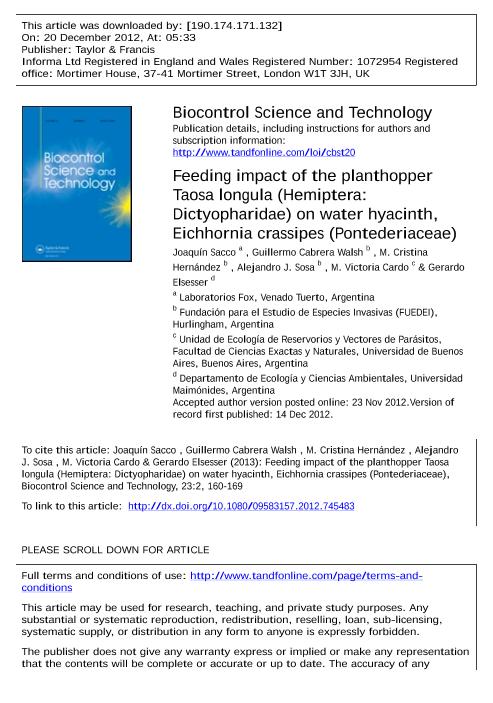Artículo
Feeding impact of the planthopper Taosa longula (Hemiptera: Dictyopharidae) on water hyacinth, Eichhornia crassipes (Pontederiaceae)
Sacco, Joaquín; Cabrera Walsh, Guillermo José; Hernández, M. Cristina; Sosa, Alejandro Joaquín ; Cardo, María Victoria
; Cardo, María Victoria ; Elsesser, Gerardo
; Elsesser, Gerardo
 ; Cardo, María Victoria
; Cardo, María Victoria ; Elsesser, Gerardo
; Elsesser, Gerardo
Fecha de publicación:
01/2013
Editorial:
Taylor & Francis
Revista:
Biocontrol Science and Technology
ISSN:
0958-3157
Idioma:
Inglés
Tipo de recurso:
Artículo publicado
Clasificación temática:
Resumen
Taosa longula Remes Lenicov (Hemiptera: Dictyopharidae), a planthopper native to South America, is a candidate for the biological control of water hyacinth, Eichhornia crassipes (Mart.) Solms-Laubach (Pontederiaceae), a serious weed worldwide. Biological control requires agents that are not only specific but also effective. Damage caused by sap-sucking insects is difficult to assess. In this work we designed an experimental and analytical procedure to evaluate the potential damage of T. longula on water hyacinth. The damage that T. longula causes to the clonal reproduction, biomass production, and growth of water hyacinth was studied through a paired greenhouse trial with floating cages. The performance of the plant, starting from two plants per treatment, was evaluated at different insect densities (5, 10, 15 and 20 nymphs per cage) until all the nymphs moulted to adults. The tests showed that individual growth and biomass production of water hyacinth was reduced due to the effect of the insect feeding above five nymphs per cage. The number of new plants produced by clonal reproduction was only significantly different above 15 nymphs per cage. These results suggest that this planthopper could be an effective agent for the biological control of water hyacinth.
Archivos asociados
Licencia
Identificadores
Colecciones
Articulos(SEDE CENTRAL)
Articulos de SEDE CENTRAL
Articulos de SEDE CENTRAL
Citación
Sacco, Joaquín; Cabrera Walsh, Guillermo José; Hernández, M. Cristina; Sosa, Alejandro Joaquín; Cardo, María Victoria; et al.; Feeding impact of the planthopper Taosa longula (Hemiptera: Dictyopharidae) on water hyacinth, Eichhornia crassipes (Pontederiaceae); Taylor & Francis; Biocontrol Science and Technology; 23; 2; 1-2013; 160-169
Compartir
Altmétricas



